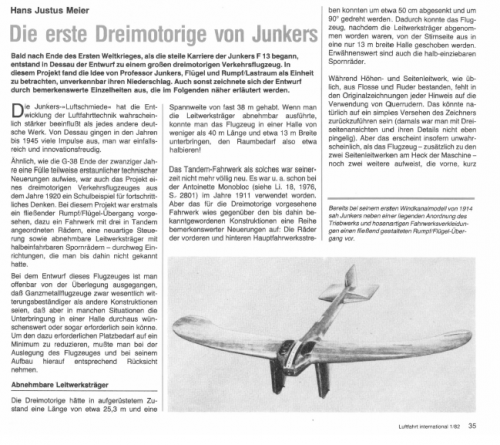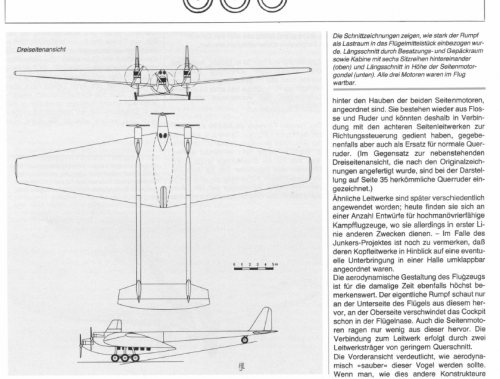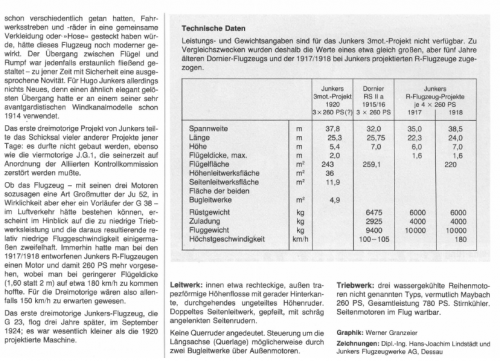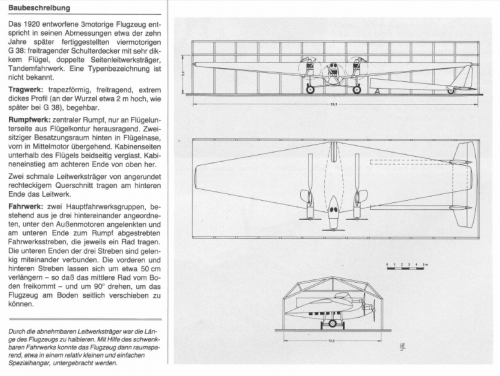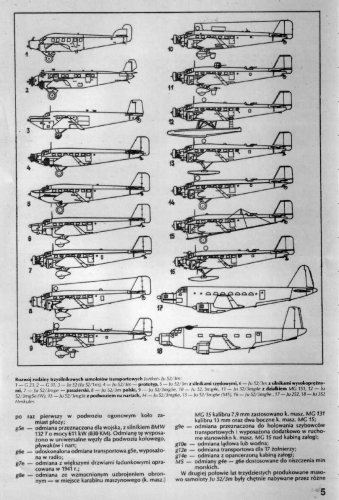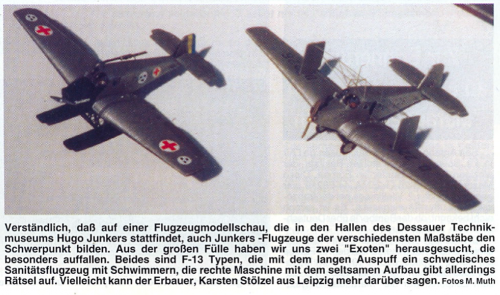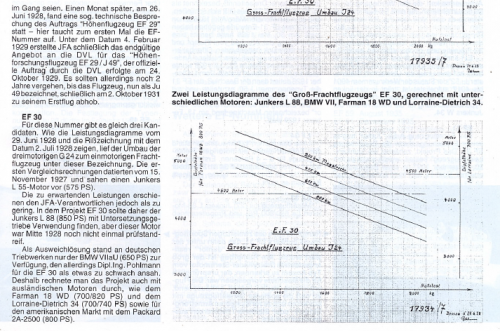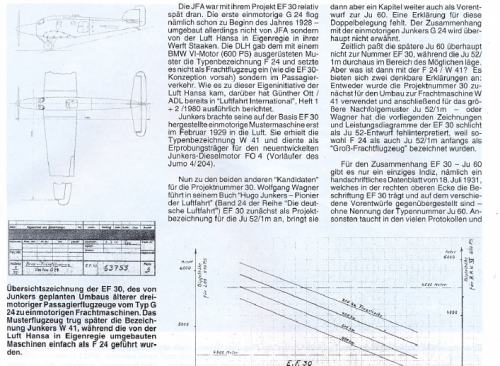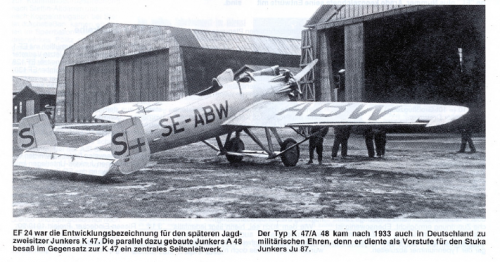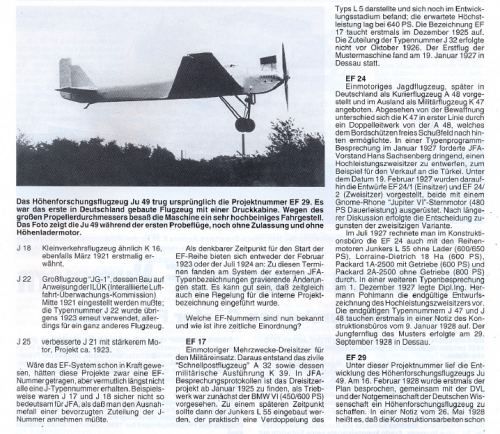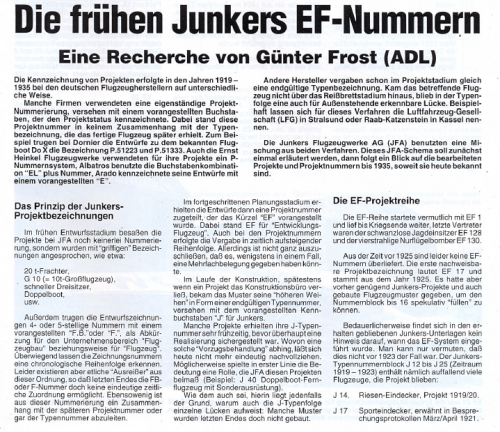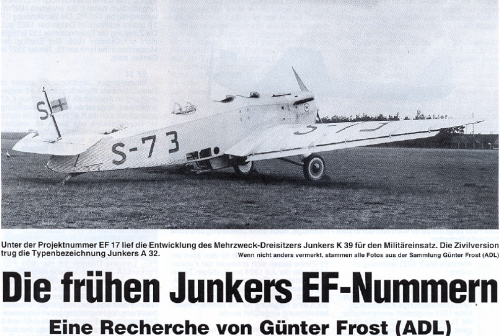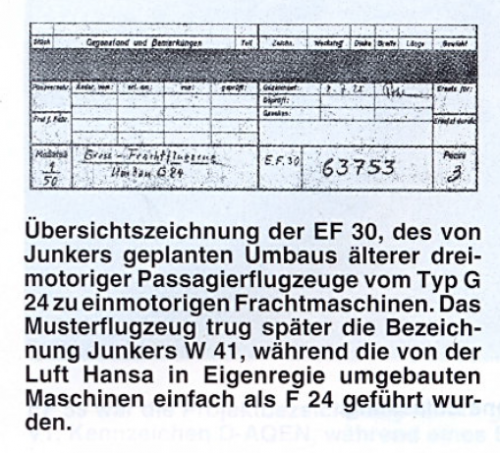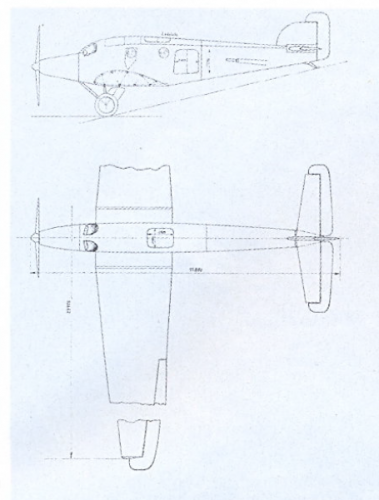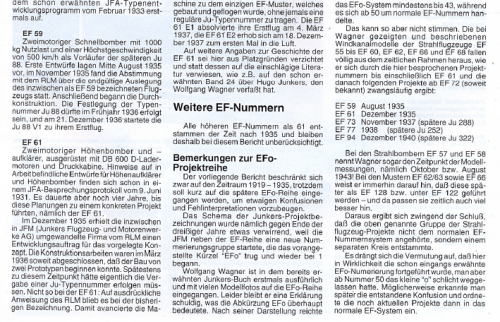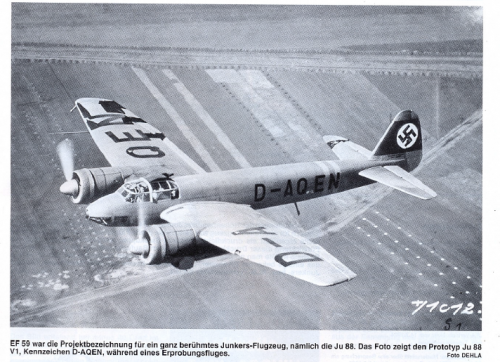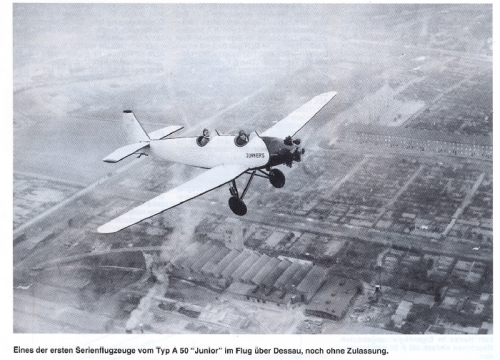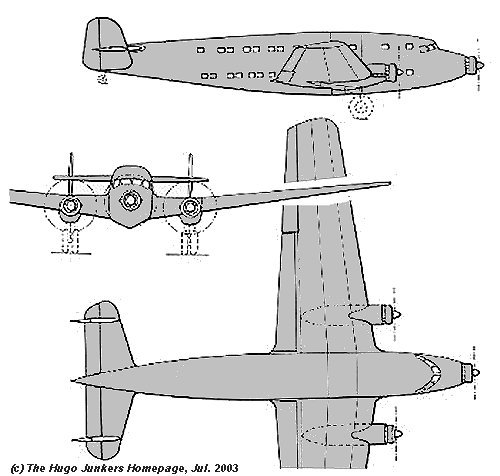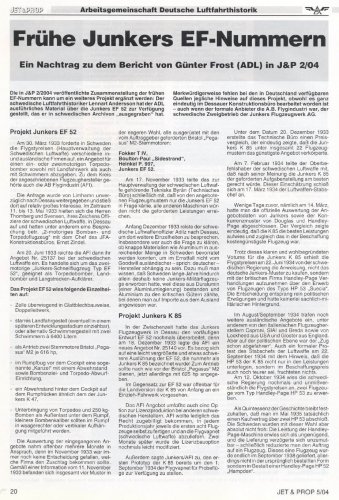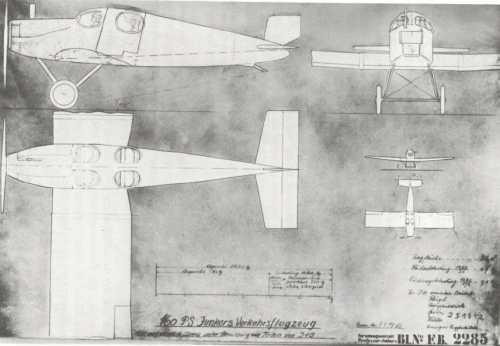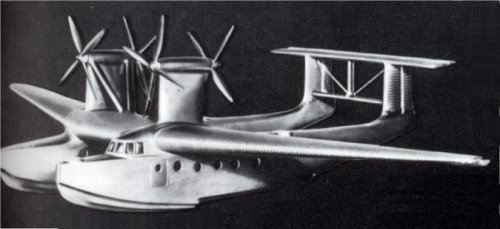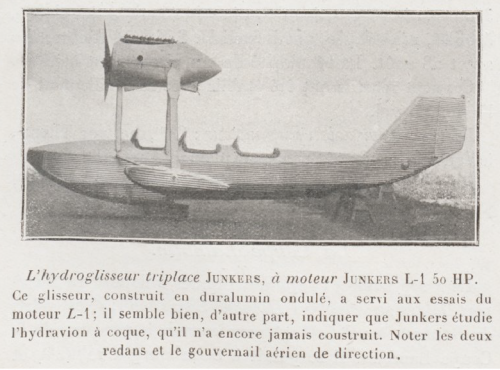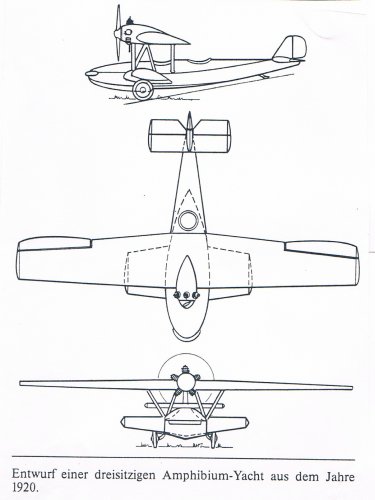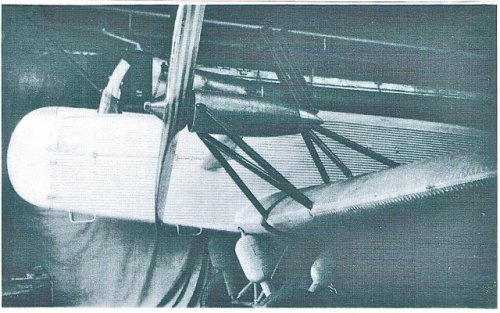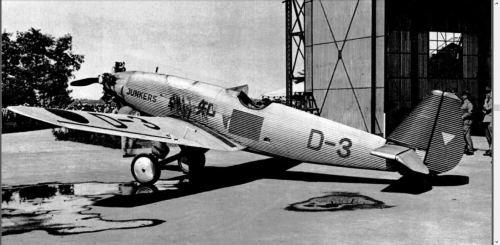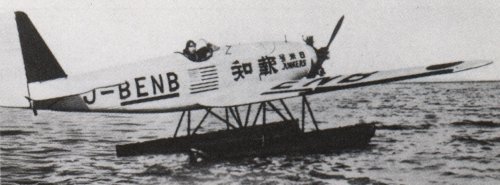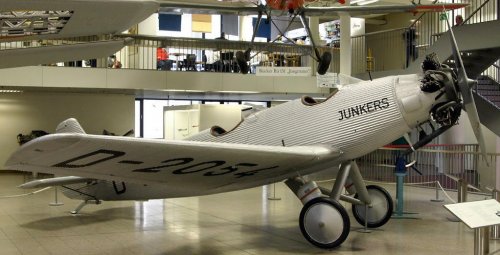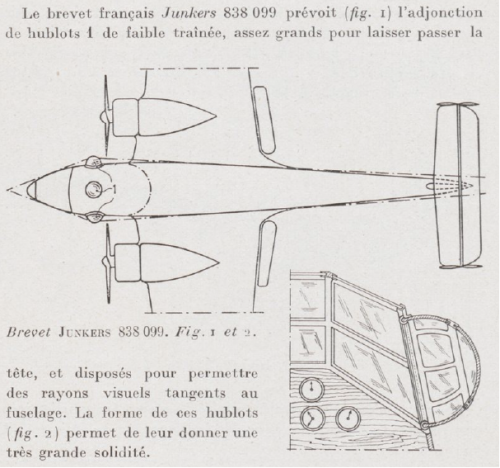You are using an out of date browser. It may not display this or other websites correctly.
You should upgrade or use an alternative browser.
You should upgrade or use an alternative browser.
Junkers Projects and Prototypes 1919 - 1939
- Thread starter raravia
- Start date
- Joined
- 11 March 2006
- Messages
- 8,621
- Reaction score
- 3,771
Those additional rudders are mentioned, but their reason seems not to be clear. It is said, that
they might replace the ailerons, but this design actually is fitted with ailerons. And for extreme
manoeuverbility, as such rudders were tested on some fighter, the design seems not very appropriate.
they might replace the ailerons, but this design actually is fitted with ailerons. And for extreme
manoeuverbility, as such rudders were tested on some fighter, the design seems not very appropriate.
- Joined
- 11 March 2006
- Messages
- 8,621
- Reaction score
- 3,771
Careful, there's quite probably no way to fly such an aircraft without a tail, that isn't designed that way,
maybe not even today, stretching the capabilities of electronic flight control systems to its limits.
And there's no mention in the text, that it was a tailless design.
An addition, I found after second reading: Ailerons could only be found in the reconstruction of the drawings,
but not in the original ones ! That actually could explain the second pair of rudders.
maybe not even today, stretching the capabilities of electronic flight control systems to its limits.
And there's no mention in the text, that it was a tailless design.
An addition, I found after second reading: Ailerons could only be found in the reconstruction of the drawings,
but not in the original ones ! That actually could explain the second pair of rudders.
If so, I wonder why a set of fins and rudders would be preferred to ailerons, which were already the established norm.Jemiba said:An addition, I found after second reading: Ailerons could only be found in the reconstruction of the drawings,
but not in the original ones ! That actually could explain the second pair of rudders.
The nearness to the propellor might suggest something to do with controlling the interaction of propeller, wing, and tail. The normal fins and rudders look a bit small to my untutored eye. In take-off attitude, it looks like they would be largely blanked by the large, thick -section wing. So perhaps the forward fins and rudders were supposed to increase control at high angles of attack?
- Joined
- 11 March 2006
- Messages
- 8,621
- Reaction score
- 3,771
iverson said:...In take-off attitude, it looks like they would be largely blanked by the large, thick -section wing. ...
Principally correct, I think, but the bigger problem may have been the elevator, I think. As long, as the tail
doesn't provide control force, direction may still be corrected via the tail wheel. And when the tail plane
lifts off the tail, the rear rudder gains control, too. The forward rudders maybe should be used to allow
some degree of lateral shift without wing drop, probably especially useful during landing approach.
- Joined
- 26 May 2006
- Messages
- 34,815
- Reaction score
- 15,696
- Joined
- 6 November 2010
- Messages
- 5,246
- Reaction score
- 5,473
The aircraft on the left is a Swedish ambulance aircraft.
The aircraft on the right appears to have D-226 for registration.
Found this about D-226:
It seems a Junkers F.13 D-226 was used to test Junkers G.38 rudders.
The aircraft on the right appears to have D-226 for registration.
Found this about D-226:
Source http://public-transport.net/VIP/airline/oelag/data_en.htmJunkers, D-226, first flight 19.02.1923; Aero-Express Hungary, H-MACD, July 1923; Junkers, D-226; 1928 returned to Junkers; test bed for skies in Königsberg (Deruluft); tail tests for G-38; registration canceled in 1932
It seems a Junkers F.13 D-226 was used to test Junkers G.38 rudders.
- Joined
- 26 May 2006
- Messages
- 34,815
- Reaction score
- 15,696
From Jet & Prop 2/2004, a surprise,
here is an article talks about some Junkers aircraft and projects,and there is many unknown
projects in it,that is including; EF-29,EF-34,EF-37,EF-48 & EF-49.
Also the EF-17 was the basis for K 39,and the J.14,J.17,J.18,J.22 & J.25 are different from,
we knew before,I hope my dear Jemiba,can translate in brief,to those new projects.
And one drawing to EF-30.
here is an article talks about some Junkers aircraft and projects,and there is many unknown
projects in it,that is including; EF-29,EF-34,EF-37,EF-48 & EF-49.
Also the EF-17 was the basis for K 39,and the J.14,J.17,J.18,J.22 & J.25 are different from,
we knew before,I hope my dear Jemiba,can translate in brief,to those new projects.
And one drawing to EF-30.
Attachments
- Joined
- 11 March 2006
- Messages
- 8,621
- Reaction score
- 3,771
Translation of "EF-30 data:
“General arrangement drawing of the EF 30, a planned modification of older 3-engined
Typ G 24 into single engine freighters. The prototype later was designated Junkers W41,
Whereas those aircraft modified by the Lufthansa on its own were simply labeled “F 24””
Of that article, written by Günter Frost, German aviation journalist, I’ll give a summary :
- The EF-series probably started with EF 1, but no evidence before 1925 is known and the date of its
Introduction isn’t know, too. Between 1919 and 1923 the J-numbers were used and several
of them remained unbuilt. The latter may have gotten an EF- instead of a J-designation, if this system
would already have been used then, so a possible starting point may have been between February
1923 and July 1924.-
The mentioned EF-designations, that aren't already mentioned in the "Junkers EF designations" thread
are added and can be found here http://www.secretprojects.co.uk/forum/index.php/topic,14756.msg225555.html#msg225555
“General arrangement drawing of the EF 30, a planned modification of older 3-engined
Typ G 24 into single engine freighters. The prototype later was designated Junkers W41,
Whereas those aircraft modified by the Lufthansa on its own were simply labeled “F 24””
Of that article, written by Günter Frost, German aviation journalist, I’ll give a summary :
- The EF-series probably started with EF 1, but no evidence before 1925 is known and the date of its
Introduction isn’t know, too. Between 1919 and 1923 the J-numbers were used and several
of them remained unbuilt. The latter may have gotten an EF- instead of a J-designation, if this system
would already have been used then, so a possible starting point may have been between February
1923 and July 1924.-
The mentioned EF-designations, that aren't already mentioned in the "Junkers EF designations" thread
are added and can be found here http://www.secretprojects.co.uk/forum/index.php/topic,14756.msg225555.html#msg225555
- Joined
- 11 March 2006
- Messages
- 8,621
- Reaction score
- 3,771
hesham said:... please can you translate the J series in the article.
I've tried to collect the J-designations from that article and other sources:
http://www.secretprojects.co.uk/forum/index.php/topic,22376.0.html
- Joined
- 26 May 2006
- Messages
- 34,815
- Reaction score
- 15,696
From Jet & Prop 5/2004,
and this article sent by my dear Borovik before;
http://www.secretprojects.co.uk/forum/index.php/topic,14756.msg151346.html#msg151346
although I know some Heinkel projects in 900s series,but it's first time to see this Heinkel
P.997,and it seems to be a transport/bomber aircraft project,do you know more about it ?.
and this article sent by my dear Borovik before;
http://www.secretprojects.co.uk/forum/index.php/topic,14756.msg151346.html#msg151346
although I know some Heinkel projects in 900s series,but it's first time to see this Heinkel
P.997,and it seems to be a transport/bomber aircraft project,do you know more about it ?.
Attachments
- Joined
- 11 March 2006
- Messages
- 8,621
- Reaction score
- 3,771
Of course, but then please reduce it to a cut out of the small part about the
He P.997, or Boulton-Paul Sidestrand or Fokker T.IV, which are mentioned just as a
side note, without any further comment. Otherwise may lead to a lot of confusion,
as the article itself is solely about Junkers projects. Or you just cite from it, mentioning
the source.
He P.997, or Boulton-Paul Sidestrand or Fokker T.IV, which are mentioned just as a
side note, without any further comment. Otherwise may lead to a lot of confusion,
as the article itself is solely about Junkers projects. Or you just cite from it, mentioning
the source.
- Joined
- 11 March 2006
- Messages
- 8,621
- Reaction score
- 3,771
Found in Wolfgang Wagners "Geschichte der deutschen Luftfahrzeugtechnik - Von der J1 bis zur F 13", a drawing
of the J 12, which was a derivative of the J 10 into a small passenger aircraft with a semi-closed cabin.
Drawn in 1919, it already reminds on the later F 13.
of the J 12, which was a derivative of the J 10 into a small passenger aircraft with a semi-closed cabin.
Drawn in 1919, it already reminds on the later F 13.
Attachments
- Joined
- 11 March 2006
- Messages
- 8,621
- Reaction score
- 3,771
Skyblazer said:Neat!
Rather draughty, I think. And perhaps somewhat strange, as during the same time, converted military
aircraft already got enclosed cabins for the pax, freeing them from the need to wear leather helmets,
flight goggles and so on. In that layout, the F 13 certainly wouldn't have secured the same commercial
success, I think.
- Joined
- 26 May 2006
- Messages
- 34,815
- Reaction score
- 15,696
Attachments
- Joined
- 11 March 2006
- Messages
- 8,621
- Reaction score
- 3,771
Am I wrong or does the second drawing show a differnt type, called
"Fernflugboot 15" (long range flying boat 15) ?
It has a single hull with qite large auxiliary foats, whereas the J 40
is a twin hull design.
"Fernflugboot 15" (long range flying boat 15) ?
It has a single hull with qite large auxiliary foats, whereas the J 40
is a twin hull design.
- Joined
- 26 May 2006
- Messages
- 34,815
- Reaction score
- 15,696
Kdmoo said:Here is the W33 experimental twin in flight and a better resolution photo of the one previously posted by hesham. Note the wood grain on the props.
Also from l'Aeronautique 1934.
Attachments
richard
ACCESS: Top Secret
- Joined
- 1 May 2006
- Messages
- 578
- Reaction score
- 141
Wurger said:The middle photo is most interesting, with the remote transmission to the propellers. This might have flown.
Yes , it flew :
Attachments
blackkite
Don't laugh, don't cry, don't even curse, but.....
- Joined
- 31 May 2007
- Messages
- 8,807
- Reaction score
- 7,678
Hi! Modified Junkers A50 long range aircraft which succeeded surprising 80hr 11404km Tokyo-Berlin flight by one Japanese pilot in 1930.
She had a additional fuel tank in covered front seat space.
Sponsor of this flight was Hochi news paper Co.Ltd.(報知新聞社)
http://en.wikipedia.org/wiki/Junkers_A50
She had a additional fuel tank in covered front seat space.
Sponsor of this flight was Hochi news paper Co.Ltd.(報知新聞社)
http://en.wikipedia.org/wiki/Junkers_A50
Attachments
Similar threads
-
-
Civilian Heinkel Projects and Prototypes
- Started by hesham
- Replies: 9
-
FVA Early Canard Aircraft and Projects from Germany
- Started by hesham
- Replies: 9
-
Projects of the German Secret Flight Test Center at Lipetsk, USSR 1924-1933
- Started by Dynoman
- Replies: 37
-

